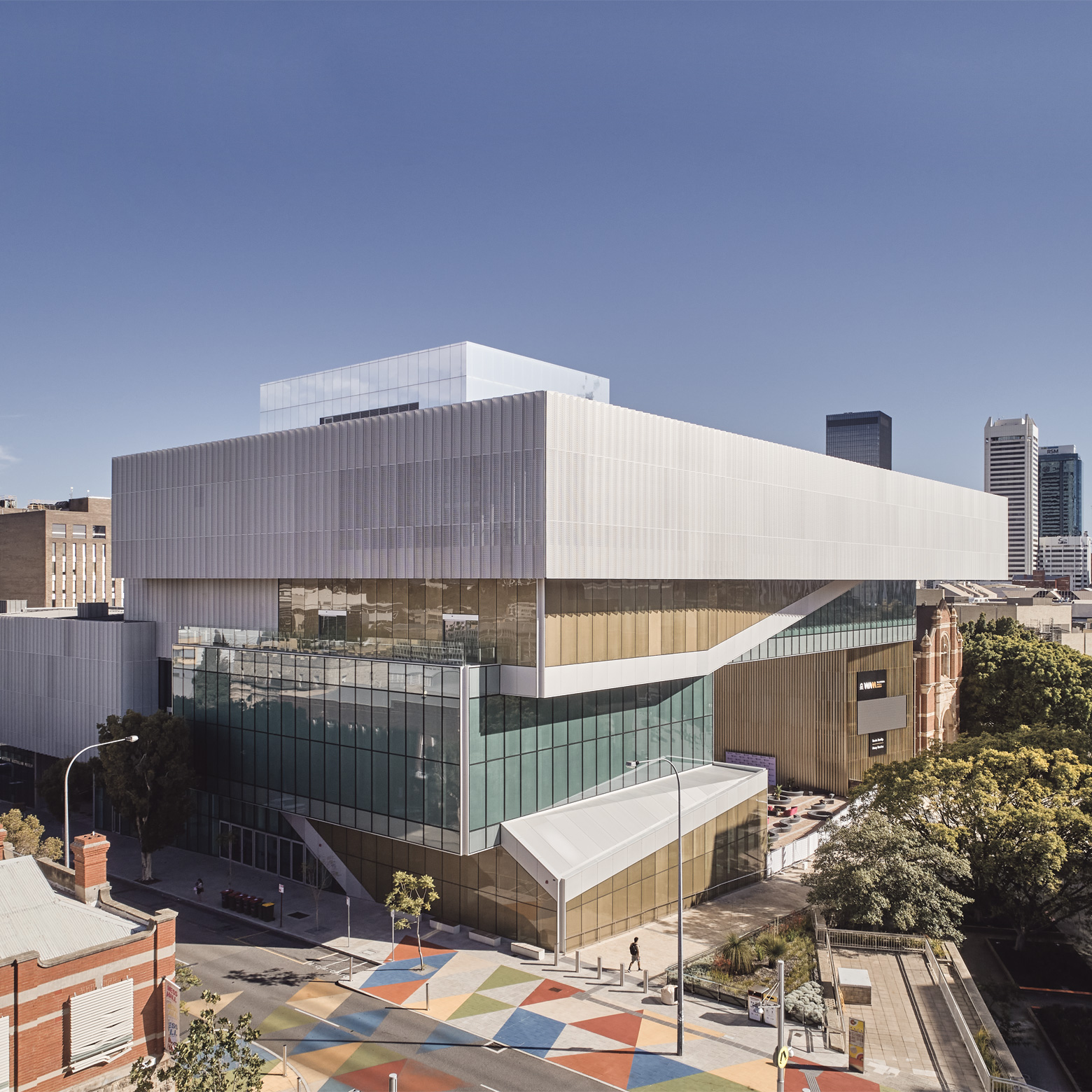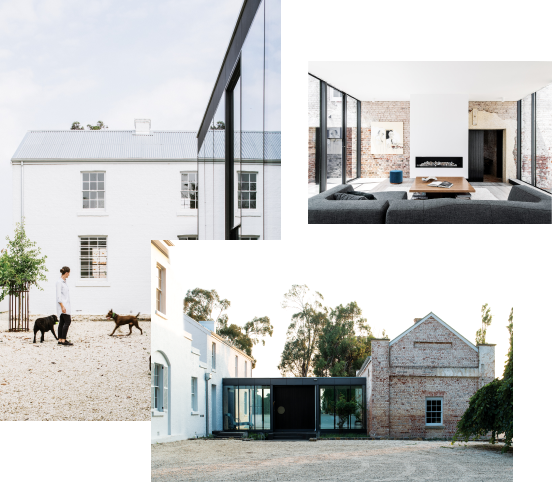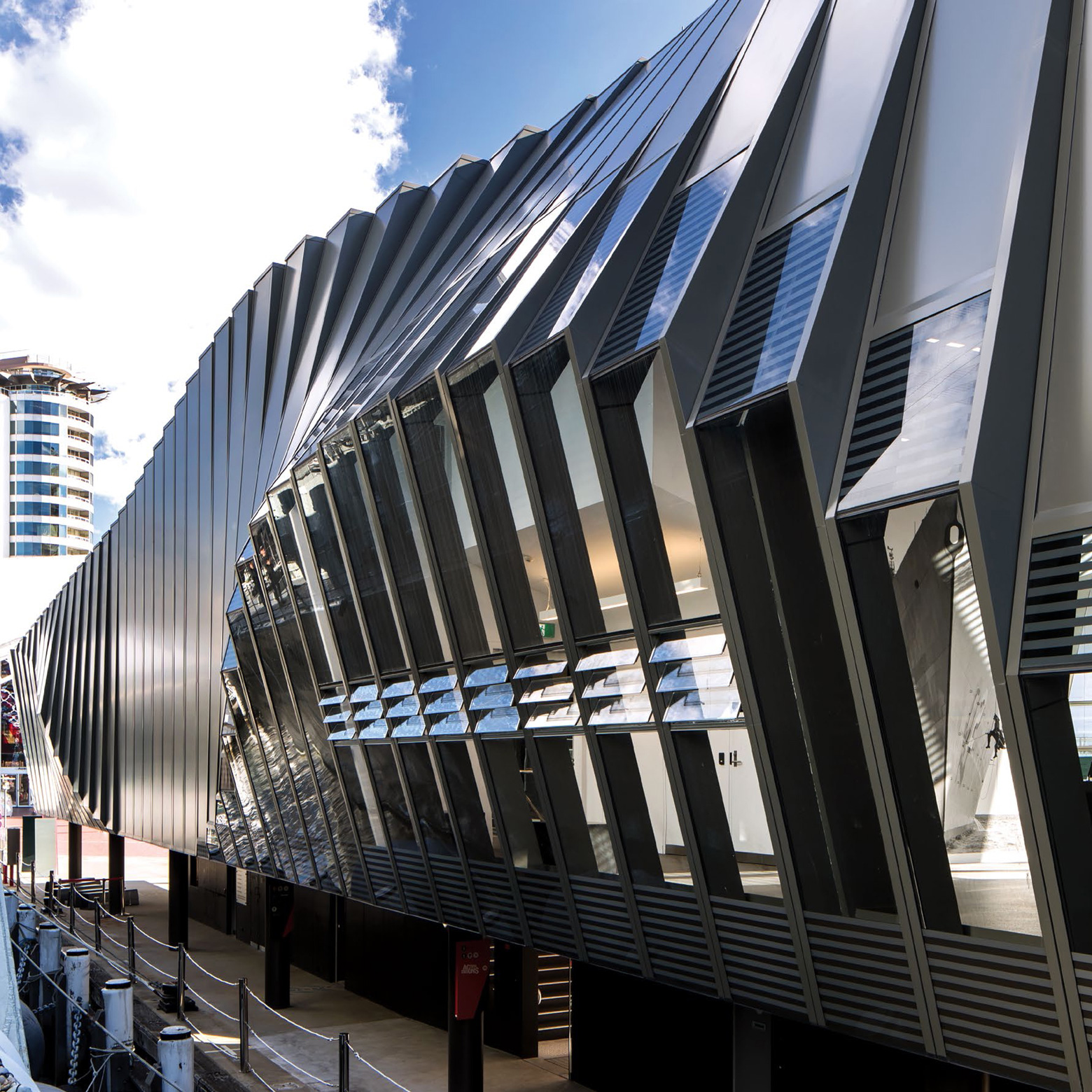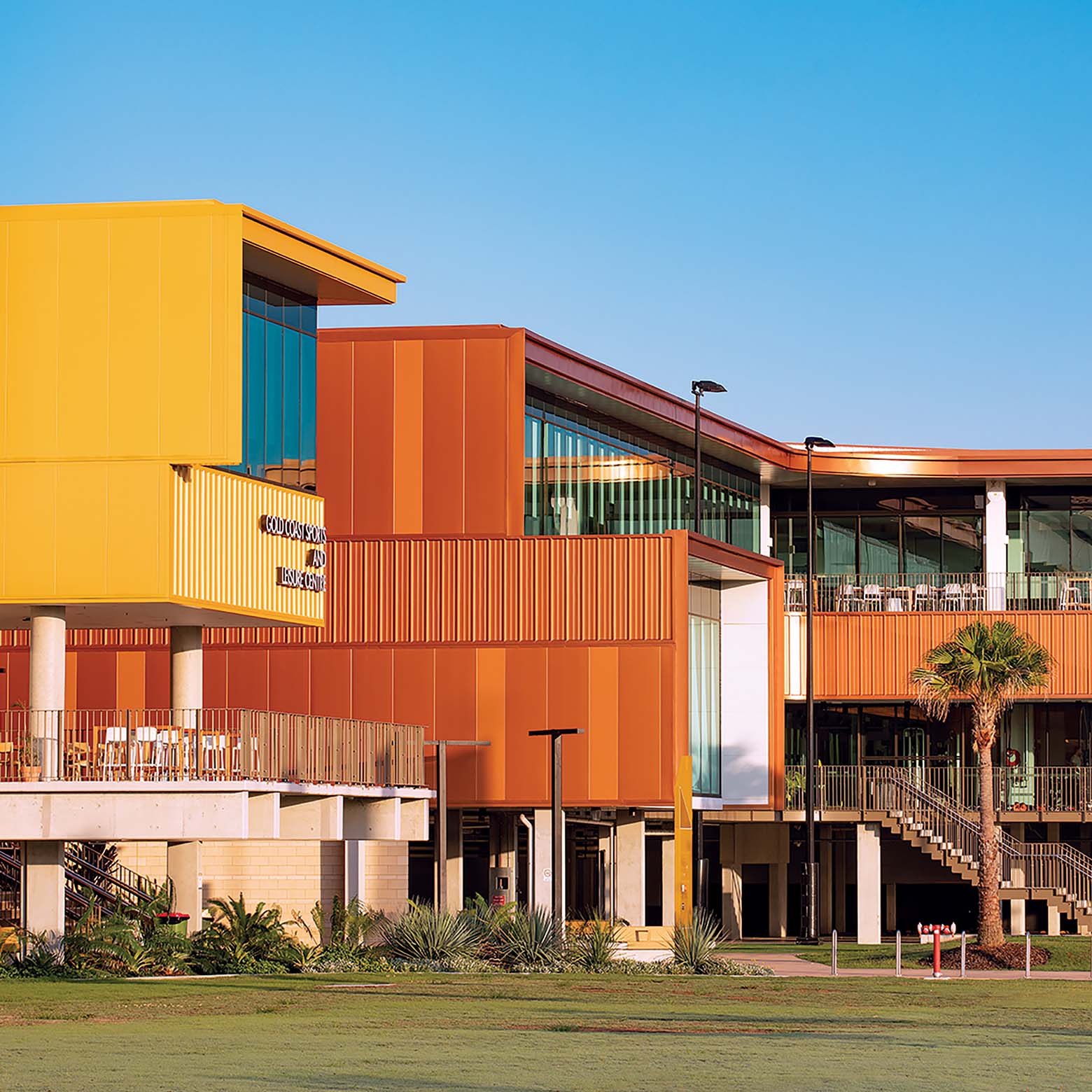
The Condensery, Somerset Regional Art Gallery
At this regional art gallery, Brisbane architects PHAB hybridise old timber with dramatically coloured new steel to make something unique.
Words: Myffy Daw.
Photography: Paul Bradshaw, Manson Images
Project Summary
PHAB architects has thrown a cloak of distinctive COLORBOND® steel cladding to repurpose an old Sunshine Coast condensed milk factory as a community arts space.
Red Coat
It’s a mark of the best architects that they show restraint. They know what not to do, when not to act, how far to go, but more importantly, when to stop. This is especially true of architects working in adaptive re-use: when faced with a building that has had a long and interesting life, and wears the scuffs and scars of that life honourably, they know that the real challenge is to not stuff it up.
The most exemplary adaptive reuse projects (think for example of Sydney’s Carriageworks, by TZG architects - STEEL PROFILE® Edition 117) manage this balance beautifully – making a building safe, accessible and useful for its new purpose, but not cleaning it up too much, not removing the detritus and marks which give it character, not killing it by making it too shiny. They don’t try to ‘restore’ a building to some mythical moment of perfection in the past, but rather they value the long duration of its life, with all the physical wear and weathering that it brings. Where a good architect does need to make insertions and interventions, these are carefully marked as new work, so as to avoid pastiche. Such restraint is a kind of architectural decorum – the demonstration of respectful good manners in relation to an existing building.

In adapting The Condensery: Somerset Regional Art Gallery from a packing shed into a sophisticated contemporary gallery space, PHAB Architects (Brant Harris and Ashley Paine) have shown that they have the restraint, decorum and subtlety that the project called for. By employing a new steel structure they were able to rescue a frail, but important, timber building. And by using a new steel cladding made from COLORBOND® steel in the highly distinctive colour Manor Red®, they were able to provide the gallery with a characteristic visual identity.
PHAB had some promising, but rather difficult, material to work with. Located amidst the rolling hills and dairy farms of the Somerset region north-west of Brisbane, the existing building was a large, timber-framed weatherboard-clad shed with a beautifully direct, exposed structure and the light and loftiness of a church hall. It had originally been part of the much larger Nestlé and Anglo-Swiss condensed milk factory, an impressive composition of buildings and chimneys arranged around a railway siding that dated from 1898. Unfortunately, almost all of these buildings burnt down in 1951 (the factory itself had ceased producing condensed milk in 1929). The timber packing shed, along with the concrete floors of some of the other buildings, were all that remained.

“It was a significant building without a civic function, slowly mouldering away in a cow paddock”
Curiously, the building was not heritage listed at either local or state level, despite the significance of the factory in the history of the town of Toogoolawah and the local area, and the architectural qualities of the remaining shed. Instead, it had for many years been the workshop and storage space of a local plumber. Over the years a new lean-to had been added to the southern side and termites had invaded the structure, leading to the whole western end of the building collapsing. During this period, the building had been the subject of much local debate and deliberation. With an important position close to the entry point to the town, and with its status as “the condensed milk factory which gave Toogoolawah its reason for being” according to one historic document, it was a significant building without a civic function, slowly mouldering away in a cow paddock.
Locals – including the very active Toogoolawah History Group – lobbied the local council to buy the building and turn it into a community centre of some mixed-use description. But it was not until 2012, when heritage consultant Benjamin Gall gathered a group of engineers, architects and a quantity surveyor to do an initial feasibility study for adaptively reusing the building, and the council was then able to use these documents to apply for state and commonwealth funding, that the project as we see it today had its origin.
PHAB was involved in that initial feasibility study and, although the brief evolved and changed over time, in the end the architectural challenge was clear: to shore up the existing structure, build a new western end including amenities and plant, and adapt the largely intact industrial interior to the complex demands of a climate-controlled, highly serviced art gallery.

PHAB made extensive use of steel, both structurally and as cladding. Steel had the advantage of being invulnerable to termites – an important consideration in a region where every other timber fence post seems to sport a termite nest, and given the original floor was being retained (allowing possible termite access through the old and cracked slab). Steel cladding was cost-effective, with low maintenance needs, and would still allow a subtle modulation of colour and some formal exuberance and ‘shape making’ in the building’s celebrated western facade. Furthermore, steel structural support members could be fine enough to unobtrusively sit behind existing timber framing.
The architects made a series of precise insertions which carefully distinguish the new additions from the original material. Harris describes how the reinforcing of the weakened timber trusses included judicious patching with steel plates (painted a fresh shade of white which differentiates them from the rest of the truss), a new face-fixed parallel flange channel reinforcing the top chord, new steel ties that brace the whole structure back to the rebuilt western end, and a new pair of steel columns on each truss line.
This was not without challenges: Paine describes how the original timber structure was warped and bent in places, and far from regular in its spacing and dimensions. This kind of structural idiosyncrasy requires exceptionally precise measurement if the duplicate steel structure is to be tailored and customised to fit each truss individually. Nevertheless, taken all together, the whole is a synthesis of the old timber and the new steel structure – a ‘composite’ engineering system.

But more than just a pragmatic structural solution, Harris and Paine note that the fine, tubular steel columns are an attempt to add to the architectural qualities of the interior – subtly defining a circulation corridor down the southern edge of the gallery. Likewise, the re-cladding and insulation of the roof was completed from the outside in, such that when standing inside the building, looking up, you can still see the original short-sheet corrugated steel that made up the once single-skin roof. This now dark-grey-from-age galvanised steel complete with its historic LYSAGHT® emblems effectively acts as a ceiling, with a whole additional layer of steel purlins, thick insulation and, above, new roof sheeting made from COLORBOND® steel in Apex Apspan 700 profile, in the colour Manor Red®.
There are restrained design touches even in how the architects have managed the plane of the roof – in the sections above what is now an air-conditioned envelope, the roof has the necessary thickness to accommodate the additional insulation and structure.
But at the eaves and above spaces which are not air-conditioned, the profile and structure is deliberately made slimmer through the use of small battens laid directly onto the original sheeting, and the use of Stramit® Corrugated profile, again made from COLORBOND® steel in the colour Manor Red®. This subtle change in profile and structure works to reduce the fascia depth while ensuring that the new roof is in keeping with the building's original lines and form.

However, the big, spectacular gesture in the project is the western facade which features walling made from COLORBOND® steel in Apex Apspan 700 profile. It is a composition in the landscape, showcasing the Manor Red® colour scheme which has become the project’s trademark – with both the roof and the western wall being in this resplendent colour. Harris tells a story of the steel contractors joking that “you’ve built it the wrong way around” – namely that the building was facing the wrong way, with its prettiest face to the surrounding paddocks rather than towards the main entry and the town. But it is precisely this western view, of an iconic red shed in a green landscape, weatherboards played off against profiled steel sheet, that has attracted attention from the local and international architectural media, as well as that of The Australian Institute of Architects, winning a State Award for Public Architecture, the Queensland 2016 COLORBOND® Award for Steel Architecture, as well as a Commendation at the Sunshine Coast Regional Architecture Awards.
These accolades seem somewhat of a surprise to the architects – who are pleased but also slightly bemused at all the attention the project has received. But really it’s no surprise – it’s a sensitive building with just the right amount of exuberance, and the whole is very deftly handled. The romance and patina of the original has been retained. In short, they didn’t stuff it up.

Panel Says
A lone reminder of a once-thriving dairy industry has been repurposed as a community arts space and workshop at Toogoolawah on Queensland’s Sunshine Coast. The town grew up around its Condensed Milk Factory which was established in 1898 and destroyed by fire in 1951. The factory’s sole remnant – a packing shed built in the 1920s – has been reborn thanks to a thoughtful overhaul and a new cloak of COLORBOND® steel cladding in the colour Manor Red®.
Whilst the architect’s deft sensitivity is evident in the treatment of the existing fabric, the sympathetic yet playful COLORBOND® steel-clad western addition provides an expression of delight that responds to program and context.
Project information
Architect
PHAB Architects
Project
The Condensery: Somerset Regional Art Gallery, Queensland
Awards
- 2016 Australian Institute of Architects Queensland Awards – COLORBOND® Award for Steel Architecture and State Award for Public Architecture
- 2016 Australian Institute of Architects Sunshine Coast Regional Awards – Commendation
- 2016 Dulux Colour Awards: Grand Prix (overall winner). Winner: Commercial Exterior category. Commendation: Commercial Interior – Public Space and Hospitality category
Location
The Condensery - Somerset Regional Art Gallery, 29 Factory Rd, Toogoolawah QLD 4313 View on Google Maps
Copyright © 2016 BlueScope Steel Limited ABN 16 000 011 058. All rights reserved.
No part of this publication may be copied, reproduced or distributed without consent. BlueScope Steel Limited, to the extent permissible at law, is not liable to any person for loss or damage arising from reliance upon information contained in this publication. The articles featured in this edition of STEEL PROFILE® are sourced, written, fact-checked and curated by the authors with editorial contribution from BlueScope Steel Limited. Any statements or opinions attributed to a person are the views of that person alone and do not necessarily reflect those of BlueScope Steel. The decision to use any particular product or material in the projects featured in this publication was made by the team involved in each project and not BlueScope Steel Limited. While care has been taken to verify the accuracy of details in this publication, BlueScope Steel Limited assumes no responsibility or liability for any errors or omissions in the content of this publication. All information is provided with no guarantee of completeness or accuracy.
Images shown throughout have been reproduced to represent actual product colours as accurately as possible. However, we recommend checking your chosen colour against an actual sample of the product before purchasing, as varying screens and devices may affect colour tones and finishes.
Every project is different and not all products are suitable for all applications, projects and environments. You should confirm the suitability of particular products for your project by contacting the supplier directly and by obtaining information and advice specific to your circumstances.
BlueScope generally recommends the use of COLORBOND® steel or ZINCALUME® steel for the majority of external cladding applications. BlueScope recommends routine preventative maintenance for eaves and other “unwashed areas” of structures that may not be regularly cleaned by rainfall. For information about product maintenance, including preventative maintenance, please call BlueScope on 1800 753 658. To determine whether a BlueScope warranty may be available for use of a product in your particular project, please visit bluescopesteel.com.au/warranties.
BlueScope, COLORBOND®, ZINCALUME®, LYSAGHT® and ® colour names are registered trademarks and ™ colour names are trademarks of BlueScope Steel Limited. Stramit® is a registered trademark of Stramit Corporation Pty Ltd. Apspan is a registered trademark of Apex Steel Pty Ltd.
Submit your project
We encourage you to share your projects for consideration in a future issue of STEEL PROFILE® magazine. We invite you to submit projects that feature a ground-breaking or an innovative use of steel. We love celebrating and writing about such projects!




